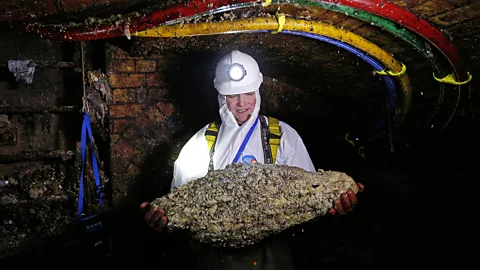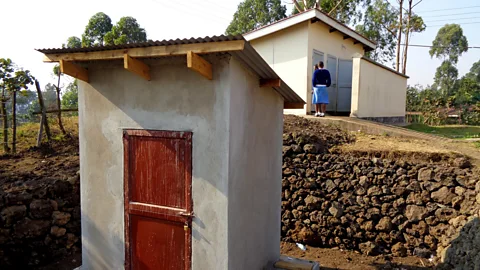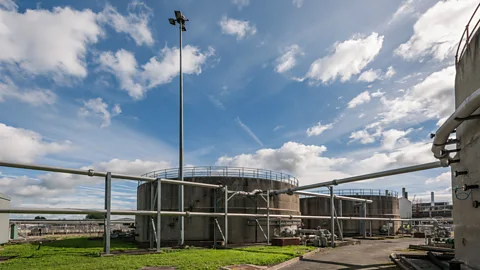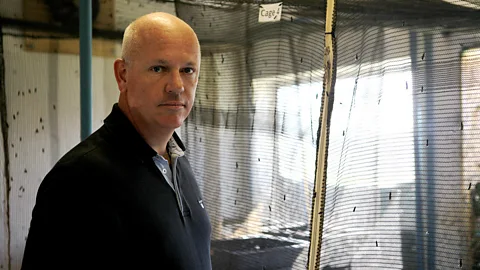'Fatbergs', faeces and other waste we flush could be a fuel

 Adrian Dennis/AFP/Getty Images
Adrian Dennis/AFP/Getty ImagesThe stuff we flush down the toilet and the fat washed down the drain could be the surprising fuel of the 21st Century – improving sanitation and creating green energy worldwide.
Grand Ideas
The 21st Century is continually throwing us new challenges and expecting us to adapt – but for every Earth-shattering megatrend, there are dozens of genius solutions. Follow them all in BBC Future's special series, Grand Ideas.
Our planet has a problem. Humans, like all living creatures, produce a lot of… well, unpleasant waste. In the form of pee and poo. Left untreated, it can poison water supplies, pollute rivers and ruin coastal areas. Unsanitary drinking water and a lack of proper toilets is a massive problem in developing areas, and in more developed areas, huge amounts of energy are needed to render our wastewater safe.
But we may be looking at our sewage in the wrong way – it may actually be a precious commodity rather than a smelly byproduct of our daily lives.
 Bristol BioEnergy Centre
Bristol BioEnergy CentreA handful of inventive engineers are finding ways to harness the potential of our bodily waste by turning it into energy that can light our homes, and fuel to power our cars. Here are a few examples of how some gross ideas could turn out to be some grand ones.
Running on pee power?
One innovative approach is turning urine into electricity with the help of bacteria.
Researchers at the University of the West of England have created compact, living power stations known as microbial fuel cells that can turn pee into power. That energy can put to such tasks as illuminating small rooms or juicing up small electronic devices.
The fuel cells are already unique in that they contain bacteria - bacteria normally found growing on the metal underside of ships and oil-rigs in the ocean. They grow on electrodes, and feed on organic matter in urine as it flows past them, producing a small current of electrons.
 Bristol BioEnergy Centre
Bristol BioEnergy Centre“This technology not only cleans the wastewater, and so improves sanitation and hygiene, but at the same time it is generating energy,” says Ioannis Ieropoulos, director of the Bristol Bioenergy Centre and professor at the university, as well as leader of the project.
The researchers have already used the pee-powered fuel cells to charge a smartphone, although it took about 64 hours to completely fill the battery on the device. The cells produce just under an amp of current and around three volts of electricity. But Ieropoulos believes it will be possible to boost the power of the fuel cells further by tweaking the materials and the process.
For parts of the world where sanitation and electricity are both scarce, it could have a dramatic impact. Worldwide, there are over 2.5 billion people without access to safe sanitation while 1.2 billion without access to electricity. In July, the team installed a stack of microbial fuel cells into a toilet block at a girls’ school in Uganda to power the lights in the cubicle, and another outside to light the path to the building at night.
 Bristol BioEnergy Centre
Bristol BioEnergy CentreThe technology could also find use in developed countries too.
“There is a huge amount of wastewater that goes down the drains every hour around the world,” he says. “This is where the greatest potential lies for the technology, if we can implement it as close to the source of the waste as possible. It can create electricity to run appliances at a household level and ease the pressure on wastewater plants.”
But the fuel of the future isn't limited to our, er, liquid creations.
Poo potential
Microbial fuel cells could also soon deal with the solid waste our bodies produce, too. Ieropoulos is working with researchers in the United States through the Bill & Melinda Gates Foundation who are developing techniques to turn solid faeces into a sludge that can flow through the fuel cells.
“We have been testing our system with faecal sludge,” says Ieropoulos. “It is much more enriched and so the microbes can generate more power.”
‘Faecal sludge’ may be an unlikely phrase to hear in the context of clean energy, but this is not the only project attempting to deal with human number twos.
In Bristol, England, Wessex Water has installed a biogas plant at its sewage works to that is turning raw sewage into 56 million litres of biomethane a day.
According to a report produced by the United Nations University in Japan, if all human faeces was converted into biogas, it could provide electricity for 138 million households.
And there are other disgusting things lurking in the sewers beneath our towns and cities that could also be put to good use.
 Wessex Water/GENeco
Wessex Water/GENecoFat fuel
In almost every city around the world huge congealed blobs of grease, oil and fat accumulate to form “fatbergs” that clog the sewers.
Among the largest to be uncovered publically was discovered last month in a stretch of Victorian sewer tunnels beneath Whitechapel in London. The 250m-long fatberg – twice the length of the football pitch at Wembley Stadium – weighed 130 tonnes and took nearly three weeks to clear. But rather than being dumped into landfill, the offending blockage was sent to an innovative processing plant to be transformed into 10,000 litres of biodiesel that can be used in buses and trucks.
The plant it was sent to is run by Argent Energy in the town of Ellesmere Port, in Cheshire, north England. It has developed a process that can turn smelly, dirty fatbergs into clean fuel by filtering out the muck, chemically altering the fat in a process called esteriesterification and then distilling it. The resulting fuel can be mixed with normal diesel so it can be used in standard diesel engines.
 Adrian Dennis/AFP/Getty Images
Adrian Dennis/AFP/Getty Images“This stuff clogs up the sewers and treatment works but it is full of material we can turn into fuel,” explains Dickon Posnett, development director at Argent Energy. Posnett estimates there are between 300,000 and 400,000 tonnes of grease and fat pulled out of the UK’s sewers and water treatment works each year while in New York, blockages caused by grease cost the city $18 million over five years.
Argent Energy’s plant currently receives around 30 tonnes of sewer fat from a single treatment works the city of Birmingham, England, each week, producing about 2,000 litres of fuel. But Posnett believes the plant could pump out up to 90 million litres of biodiesel a year when it is fully operational.
 Argent Energy
Argent EnergyAnd it is not just fatbergs it could help deal with.
“The plant can deal with all sorts of highly degraded fats and oils,” says Posnett. “So it can take things like rancid mayonnaise or soup that has gone off. We get sent pallets and pallets of soured ghee, for example, that would otherwise be going into landfill.”
But another firm – Cape Town-based AgriProtein – has an even less pleasant way of dealing with food waste.
It breeds black soldier fly larvae that gorge themselves on the discarded food waste before they are then harvested, dehydrated and pressed to extract a rich oil from the bugs that can be sold as an eco-friendly feed for livestock.
AgriProtein already has an industrial scale plant running in South Africa to deal with food waste, but its approach is now also being applied to human waste.
“The flies love s**t,” says Marc Lewis, a director of The BioCycle, a company using AgriProtein’s flies to tackle human waste. It has set up a pilot processing plant in Isipingo, Durban, South Africa, where it receives three tonnes of faecal sludge from 80,000 toilets scattered around the country’s Kwa-Zulu Natal province.
 Jenny Goldhawk-Smith/AFP/Getty Images
Jenny Goldhawk-Smith/AFP/Getty ImagesThis smelly gloop is then inoculated with young larvae before being harvested 13 days later. Lewis anticipates it will be able to generate up to 940 litres of oil a week from the waste it receives when the plant is fully up and running. The oil is sold as fuel but there could be other opportunities too – it is high in lauric acid, a compound commonly found in coconut oil and is often used in soaps and moisturisers.
Lewis also believes there is also plenty of room for expansion in the future.
“With further research we could take our industrial knowledge to other hazardous waste streams that are becoming globally problematic,” he says. This could include animal manure or leftovers from meat processing plants.
When looked at in this way, the most unpleasant of substances could end up being the most unlikely tools to build a better future.
